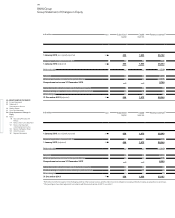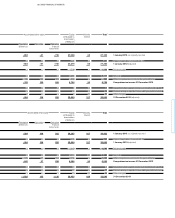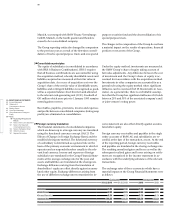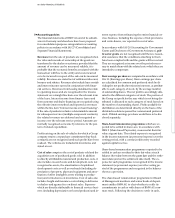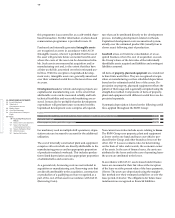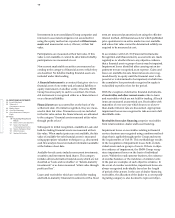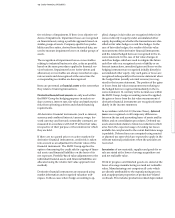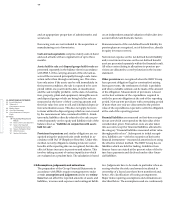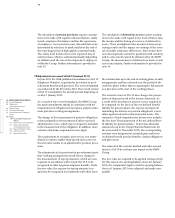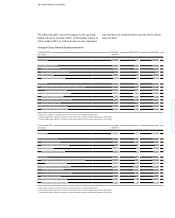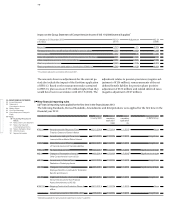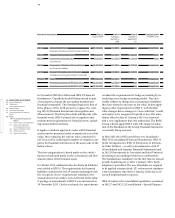BMW 2013 Annual Report Download - page 102
Download and view the complete annual report
Please find page 102 of the 2013 BMW annual report below. You can navigate through the pages in the report by either clicking on the pages listed below, or by using the keyword search tool below to find specific information within the annual report.
102
88 GROUP FINANCIAL STATEMENTS
88 Income Statements
88 Statement of
Comprehensive Income
90 Balance Sheets
92 Cash Flow Statements
94 Group Statement of Changes in
Equity
96 Notes
96 Accounting Principles and
Policies
114 Notes to the Income Statement
121 Notes to the Statement
of Comprehensive Income
122
Notes to the Balance Sheet
145 Other Disclosures
161 Segment Information
Investments in non-consolidated Group companies and
interests in associated companies not accounted for
using the equity method are reported as Other invest-
ments and measured at cost or, if lower, at their fair
value.
Participations are measured at their fair value. If this
value is not available or cannot be determined reliably,
participations are measured at cost.
Non-current marketable securities are measured ac-
cording
to the category of financial asset to which they
are classified. No held-for-trading financial assets are
included under this heading.
A financial instrument is a contract that gives rise to a
financial asset of one entity and a financial liability or
equity instrument of another entity. Once the BMW
Group
becomes party to such to a contract, the finan-
cial instrument is recognised either as a financial asset
or as a financial liability.
Financial assets are accounted for on the basis of the
settlement date. On initial recognition, they are meas-
ured
at their fair value. Transaction costs are included
in the fair value unless the financial assets are allocated
to the category “financial assets measured at fair value
through profit or loss”.
Subsequent to initial recognition, available-for-sale and
held-for-trading financial assets are measured at their
fair value. When market prices are not available, the fair
value of available-for-sale financial assets is measured
using appropriate valuation techniques e. g. discounted
cash flow analysis based on market information available
at the balance sheet date.
Available-for-sale assets include non-current investments,
securities and investment fund shares. This category
includes all non-derivative financial assets which are not
classified as “loans and receivables” or “held-to-maturity
investments” or as items measured “at fair value through
profit and loss”.
Loans and receivables which are not held for trading
and held-to-maturity financial investments with a fixed
term are measured at amortised cost using the effective
interest method. All financial assets for which published
price quotations in an active market are not available
and whose fair value cannot be determined reliably are
required to be measured at cost.
In accordance with IAS 39 (Financial Instruments:
Recognition and Measurement), assessments are made
regularly as to whether there is any objective evidence
that a financial asset or group of assets may be impaired.
Impairment losses identified after carrying out an im-
pairment test are recognised as an expense. Gains and
losses on available-for-sale financial assets are recog-
nised directly in equity until the financial asset is
dis-
posed of or is determined to be impaired, at which time
the cumulative loss previously recognised in equity is
reclassified to profit or loss for the period.
With the exception of derivative financial instruments,
all receivables and other current assets relate to loans
and receivables which are not held for trading. All such
items are measured at amortised cost. Receivables with
maturities of over one year which bear no or a lower-
than-market interest rate are discounted. Appropriate
impairment losses are recognised to take account of all
identifiable risks.
Receivables from sales financing comprise receivables
from retail customer, dealer and lease financing.
Impairment losses on receivables relating to financial
services business are recognised using a uniform method-
ology
that is applied throughout the Group and meets
the requirements of IAS 39. This methodology results
in the recognition of impairment losses both on indi-
vidual assets and on groups of assets. If there is objec-
tive
evidence of impairment, the BMW Group recog-
nises impairment losses on the basis of individual
assets. Within the retail customer business, the existence
of overdue balances or the incidence of similar events
in the past are examples of such objective evidence. In
the event of overdue receivables, impairment losses are
always recognised individually based on the length
of period of the arrears. In the case of dealer financing
receivables, the allocation of the dealer to a correspond-
ing rating category is also deemed to represent objec-




